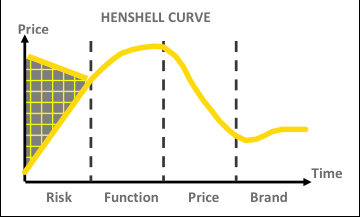
There’s a pattern in technology pricing, and the signs are that this pattern is emerging again for many of the technologies associated with the Internet of Things (IoT).
Cambashi calls the pattern the “Henshell Curve” because it was a discussion with Cambashi associate Dr. Richard Henshell that crystallized our thinking into the price development trend curve shown in the diagram.
There are four phases:
RISK: In this first phase, the technology might come from a university for free or it might cost a fortune if you commission a development team to create it for you. Each vendor in the market (and there are many) offers a different bundle of functions at a different price. We call this the risk phase, because the chosen provider may not stay the course, or the technology may not develop in the way it was planned, and these changes could leave your investment stranded. There are no benchmarks to measure against. Throughout this phase, the top priority for the buyers and users of the technology is to manage risk, and make sure their vision of the potential benefits is a reasonable balance for this risk. This phase draws to a close as the market converges around one definition of price and function.
(Related: IBM and Pfizer work on an IoT project to research Parkinson’s)
FUNCTION: Many (but not all) vendors survive into this second phase. The survivors make money, because the market grows fast and the price tends to rise, so quite a large population of vendors can prosper. The key competitive factor for the user now is function, and the leading vendors invest to deliver new functions to beat the competition. The signal for the end of this phase is the appearance of a new entrant offering 80% of the function at 20% of the price.
PRICE: In this phase, functional bundles are well defined and well understood, and price becomes the main competitive weapon. Part of the market discovers that the 80% offer is all it needs. Market leaders come under pressure and prices start to fall. This is a very challenging phase for larger companies, which have to find leaner business models in order to stay in the business.
BRAND: After the price wars, the survivors have a technology that is accepted at a price point that leaves a small profit margin. The technology tends to be treated as a commodity item, and the key competitive factor is brand.
Vendors use strategies such as portfolio planning and add-on services to smooth out their revenue and profit curves as one or more technologies progress through these phases. Each phase attracts different types of customers, from the adventurous, experimenting with the new technologies during the risk phase, to the very cautious, who buy only from respectable brands after the price battles are over.
The specific piece of research that triggered this article was some work we had done to look at “cloud providers for IoT.” This category fits into one of the six layers we use to segment IoT technology. There are of course some category gorillas—for example, Amazon Web Services for IoT; IBM Cloud (integrated into its Bluemix environment, which addresses IoT and other environments); PTC’s Axeda cloud offer alongside ThingWorx; Microsoft’s Azure IoT Suite. But you don’t have to look at this category for very long to find there are many providers, all offering something special, all with their own local or industry focus points. The available editions and pricing plans fill the shaded area in the risk phase. Some, but not all of these providers are destined for greatness, there are too many to list here, so apologies to those I haven’t included.
Is this true across the whole of the technology and tool stacks you need for IoT? No, not entirely. For example, software development tools largely follow well-defined functionality bundles. But the picture is never static: There’s always room for a new entrant, whether it’s at the left-hand side of the diagram (introducing a new technology), or as the disruptor, offering 80% of the results at 20% of the price and forcing the market into the price phase.
That’s why this is a market that is fun to watch!





